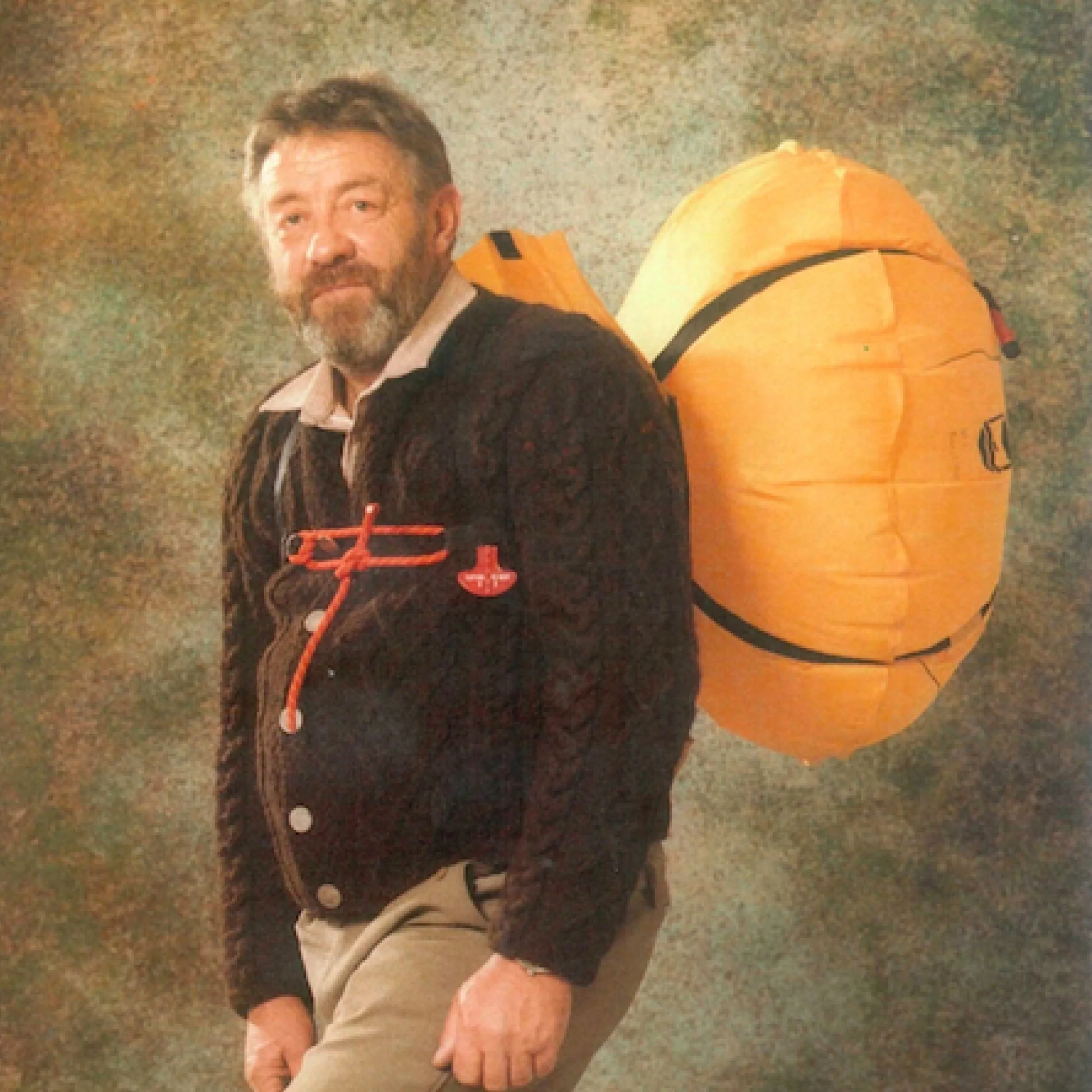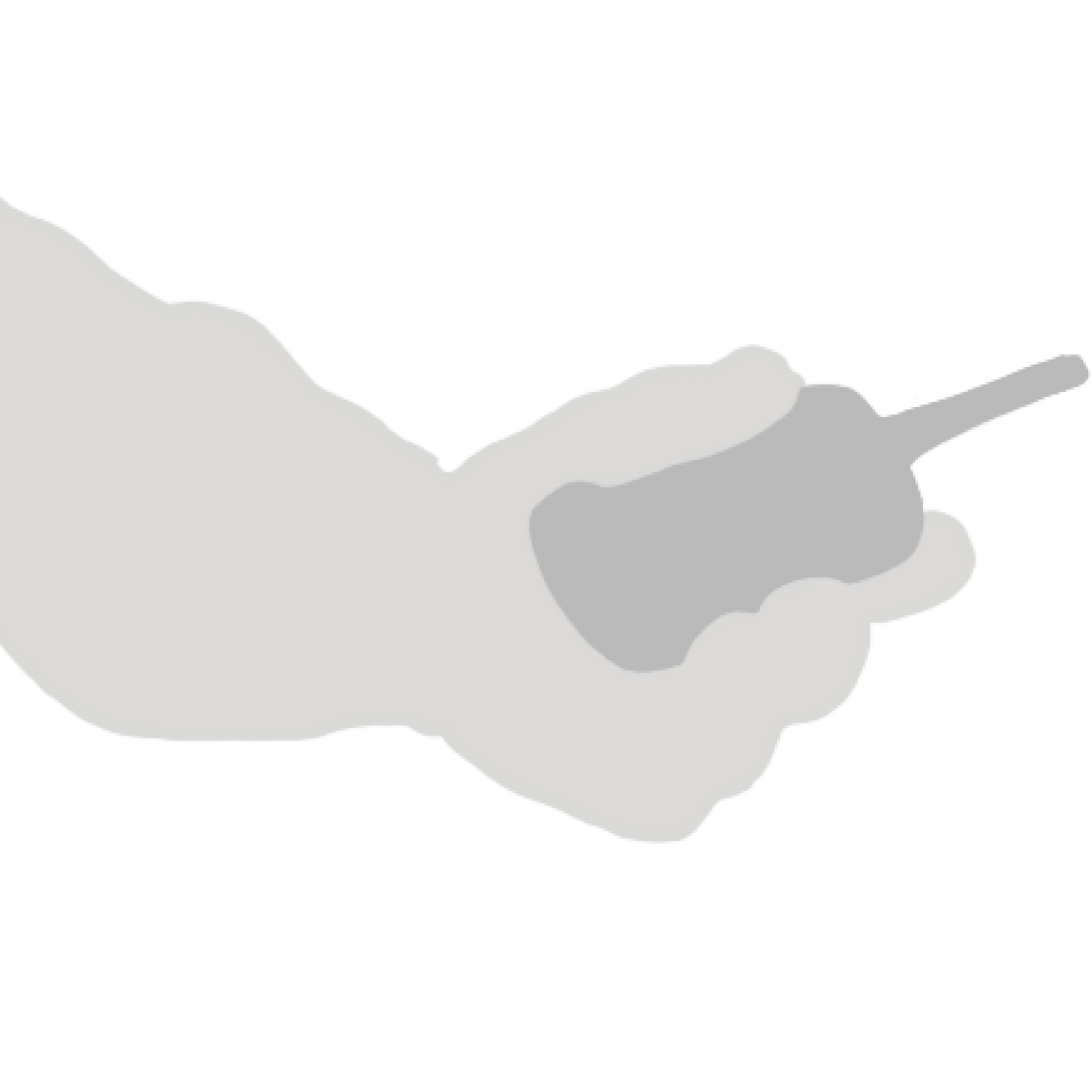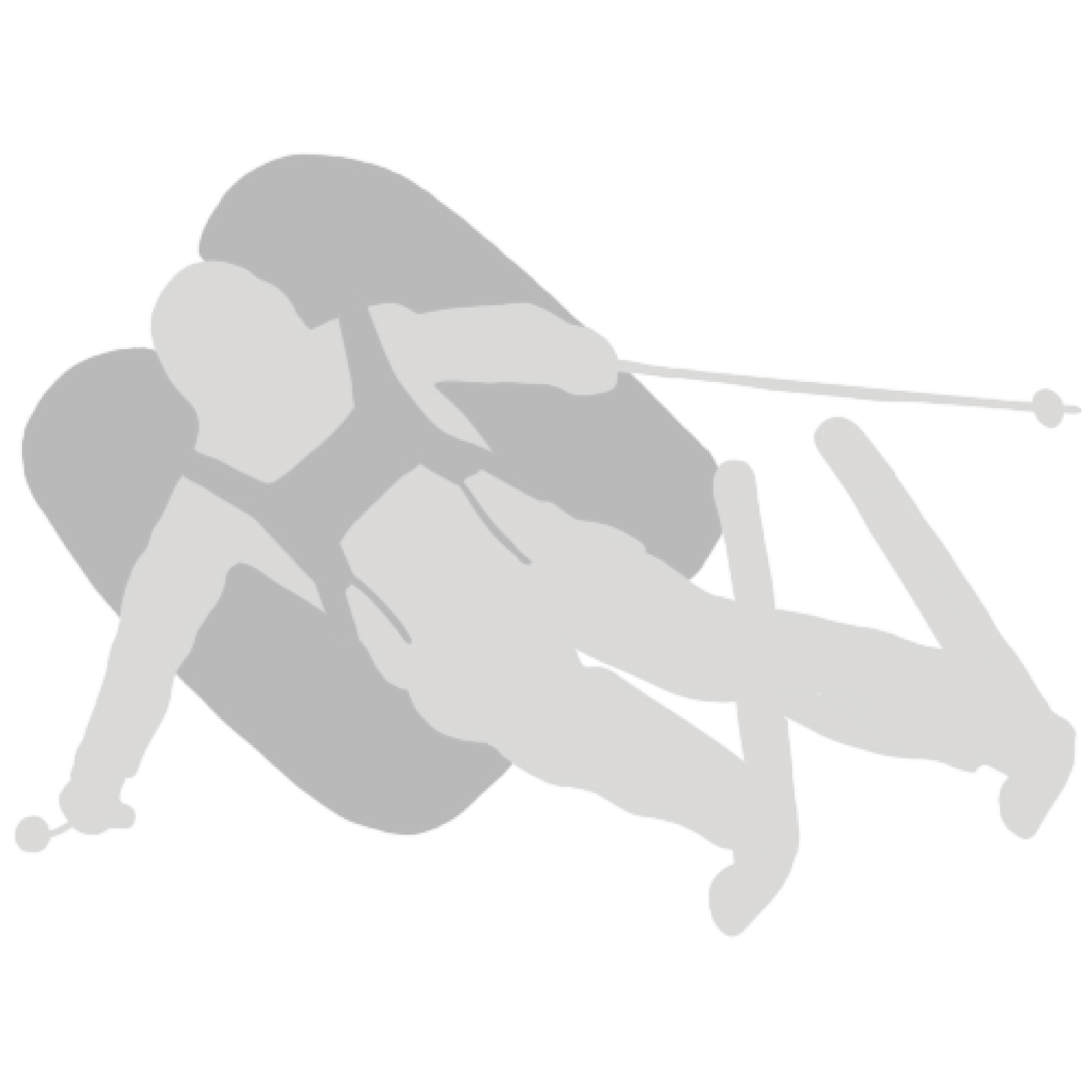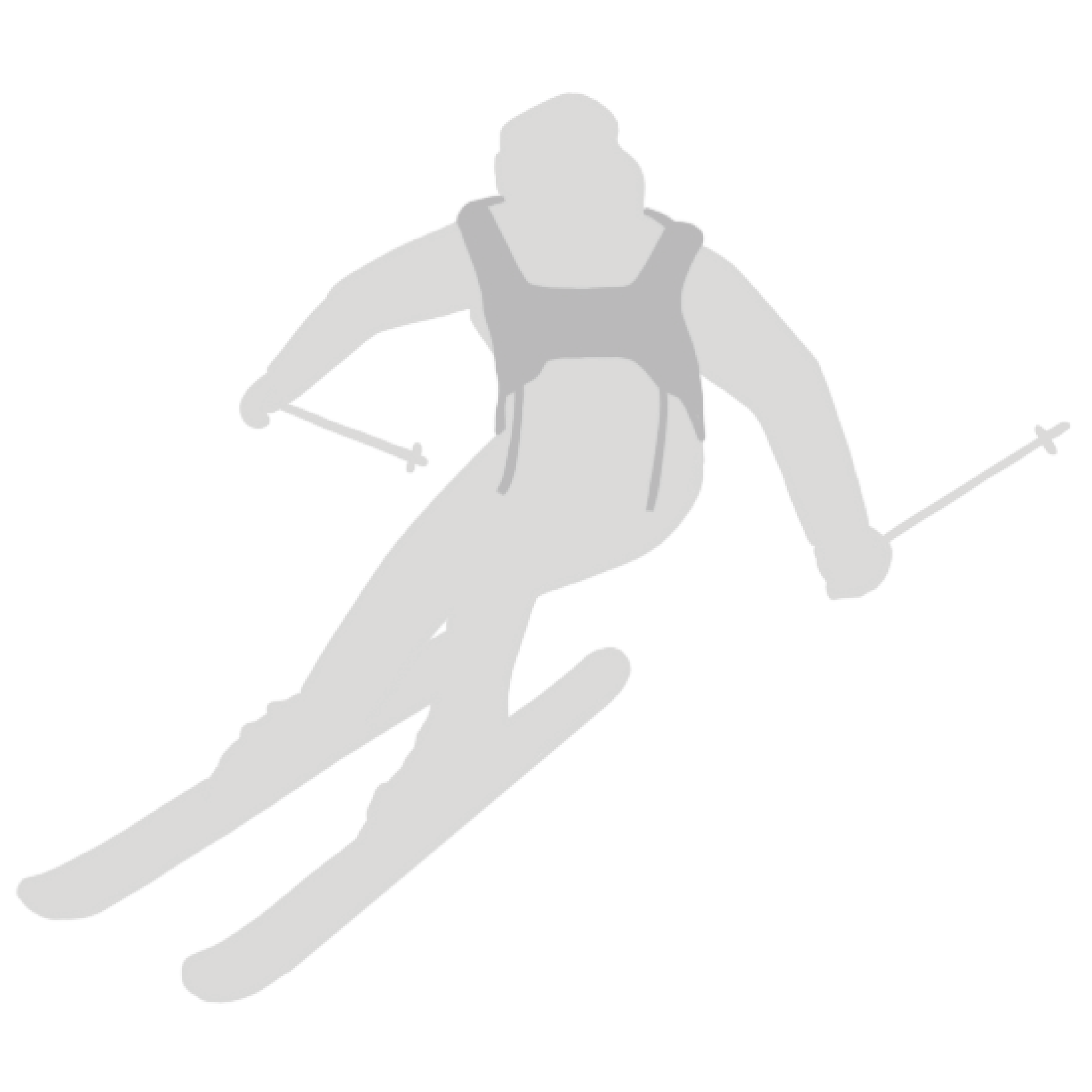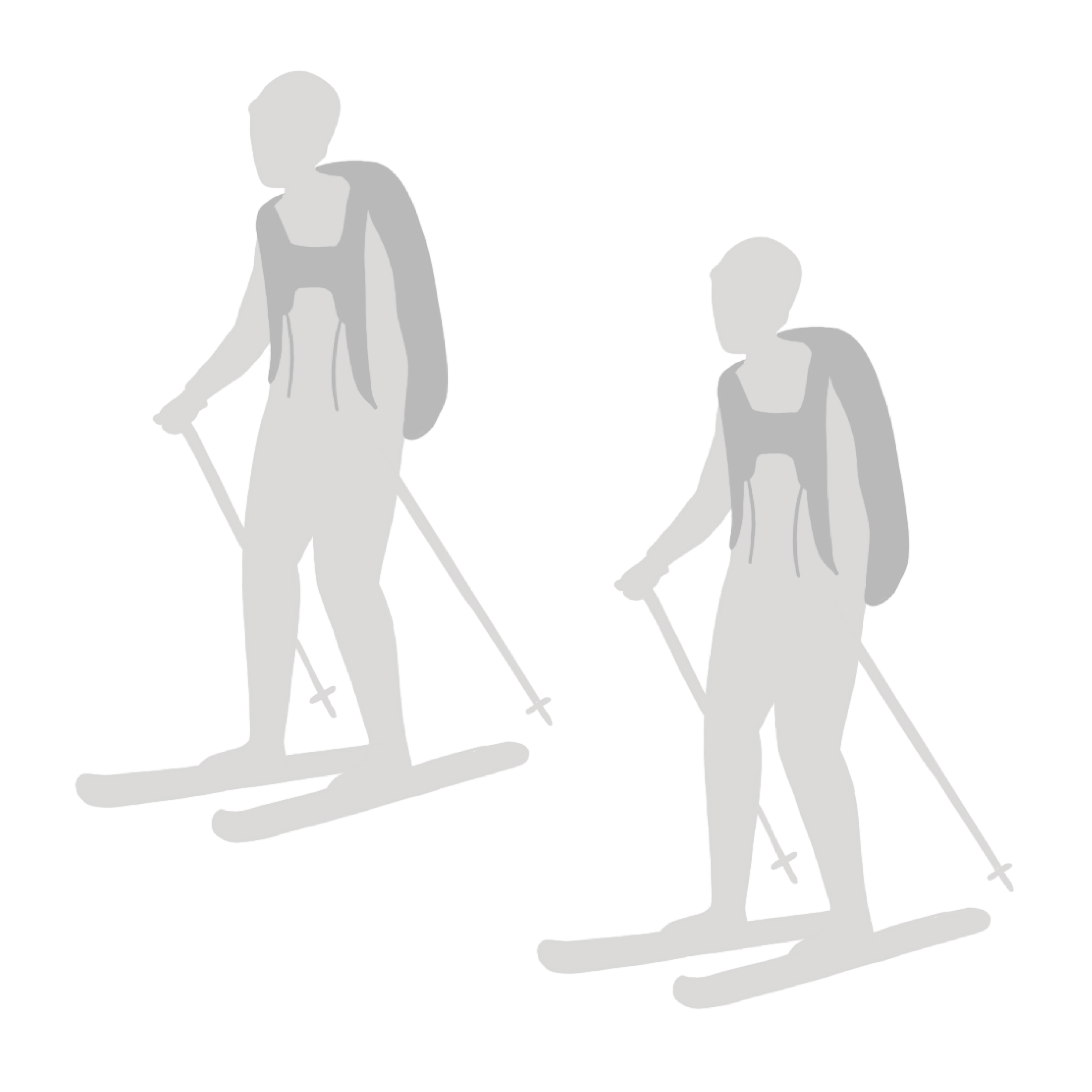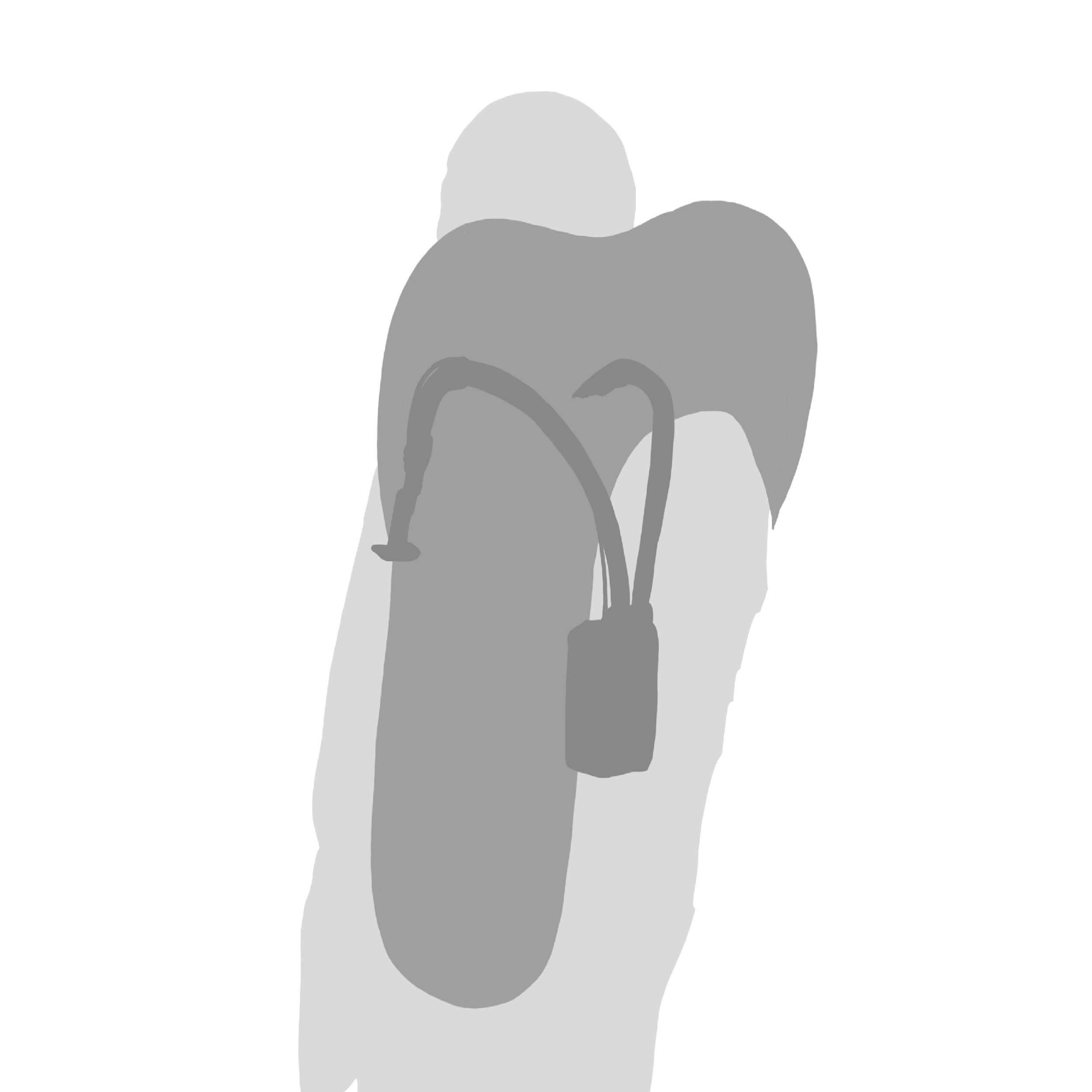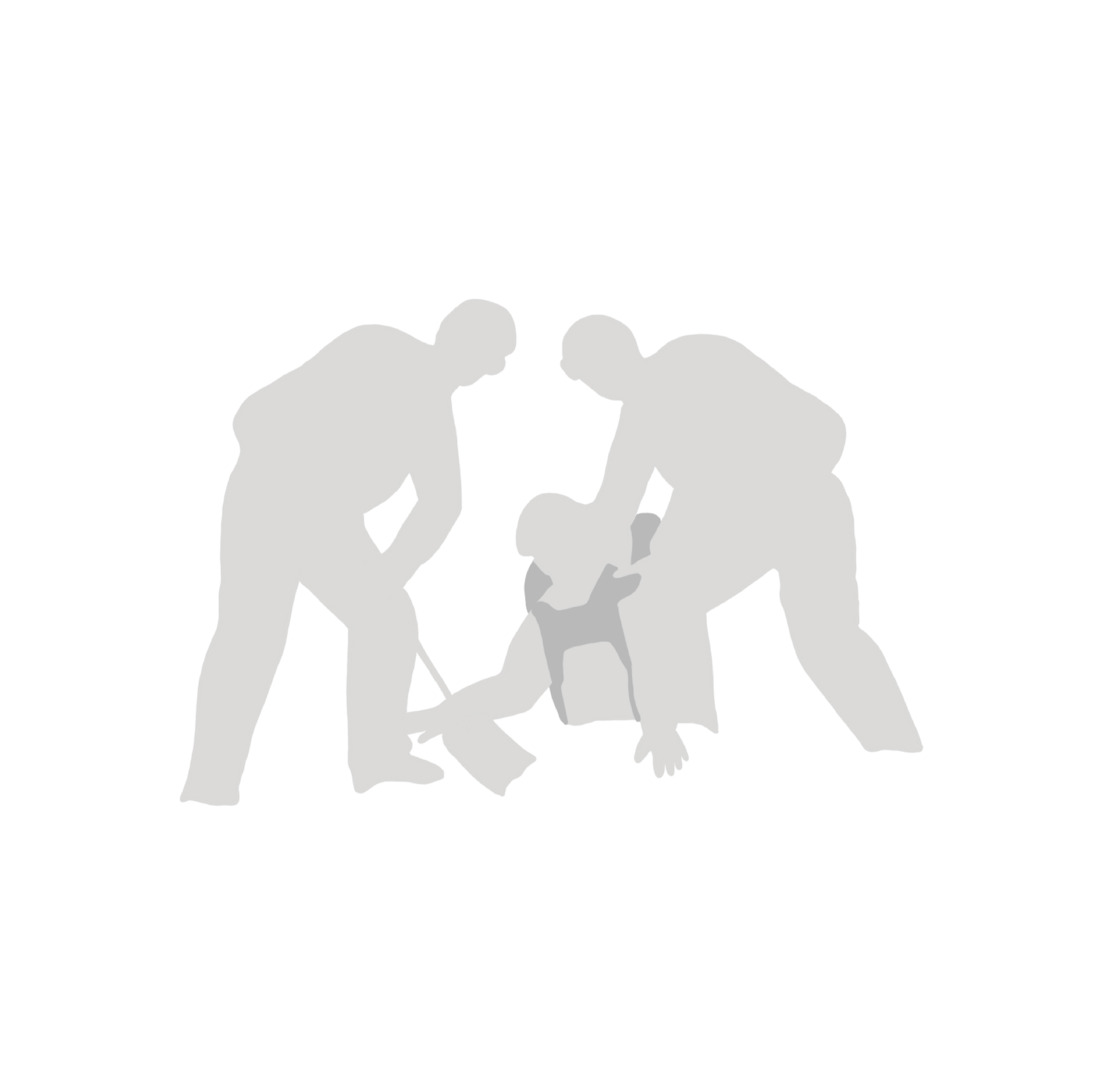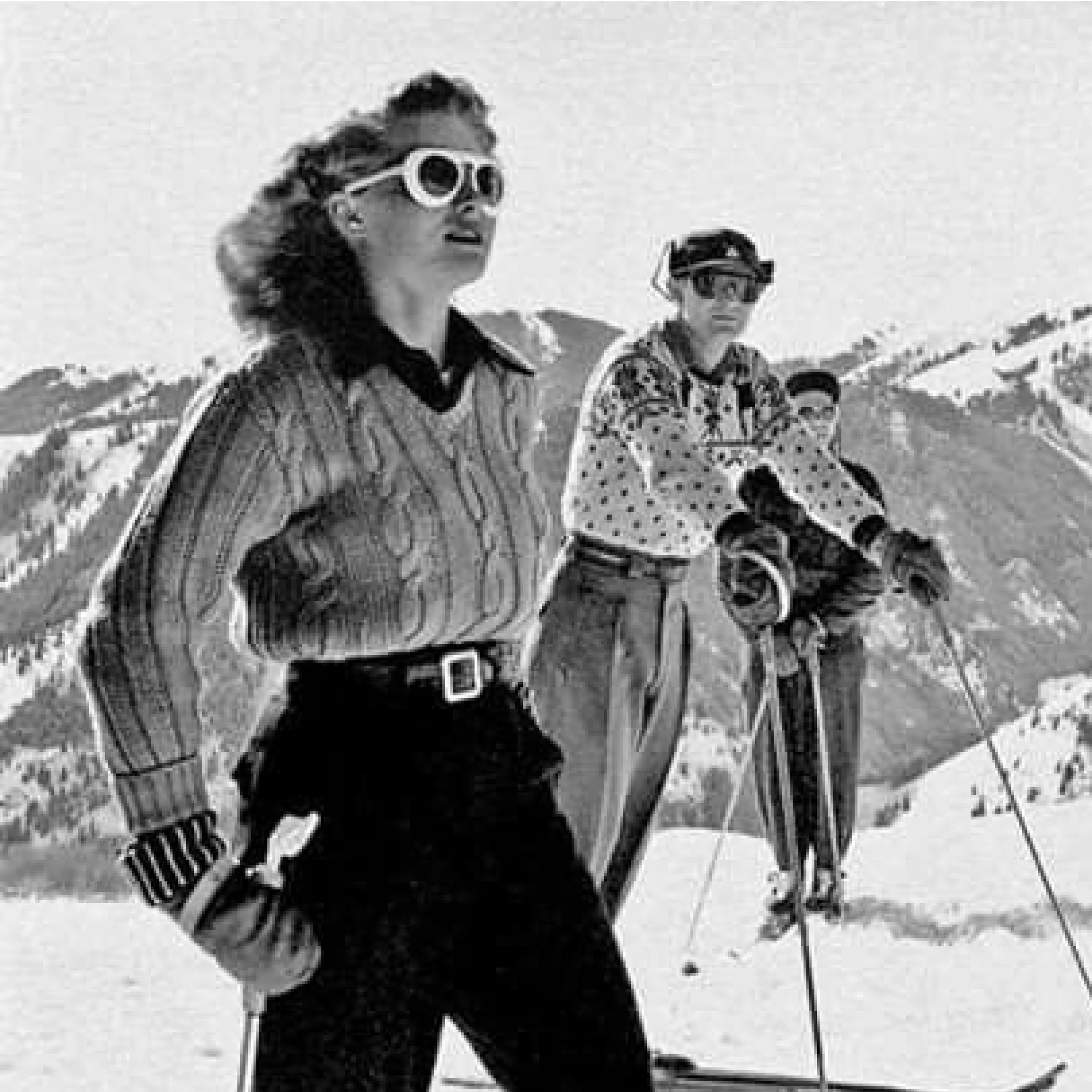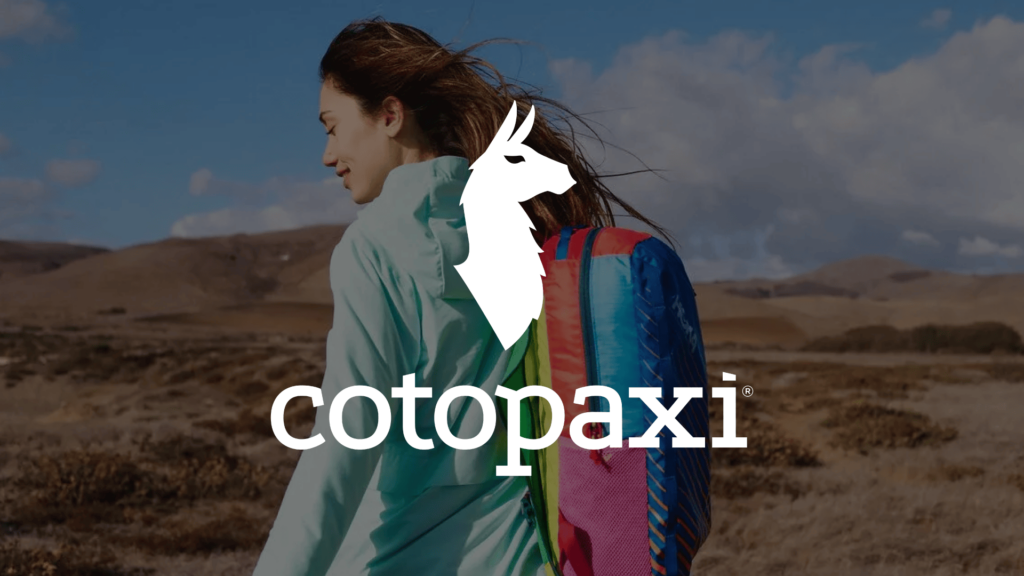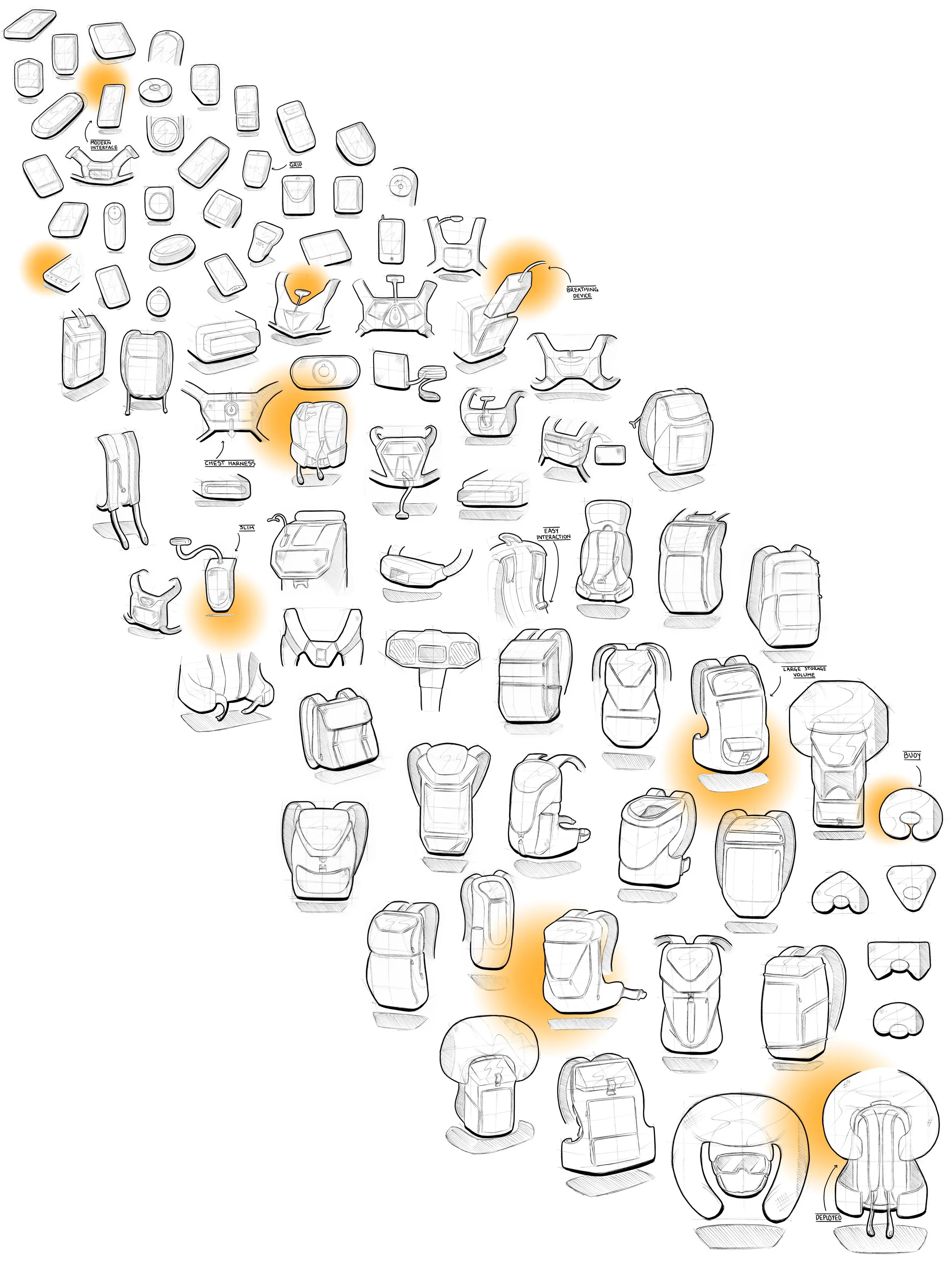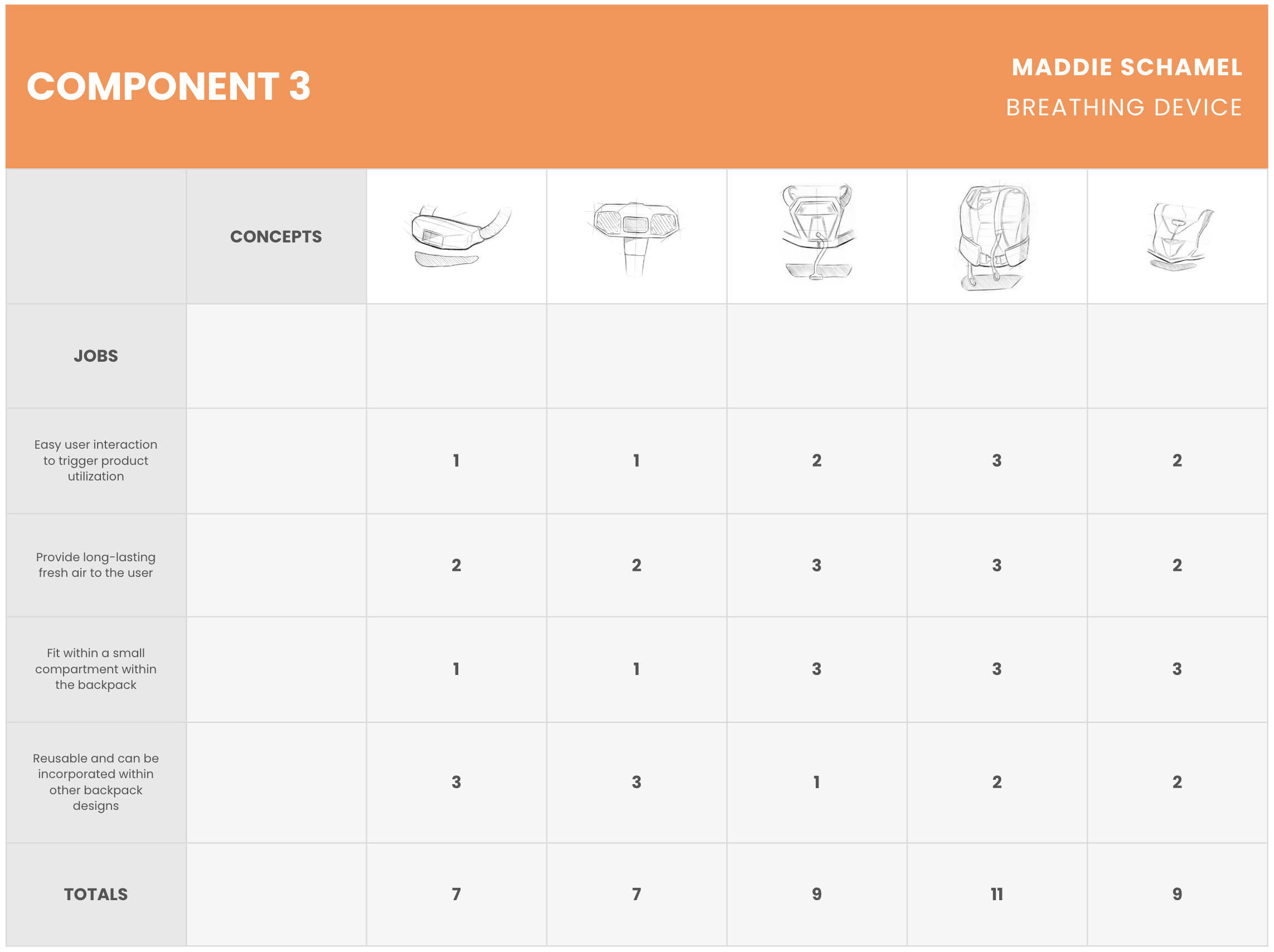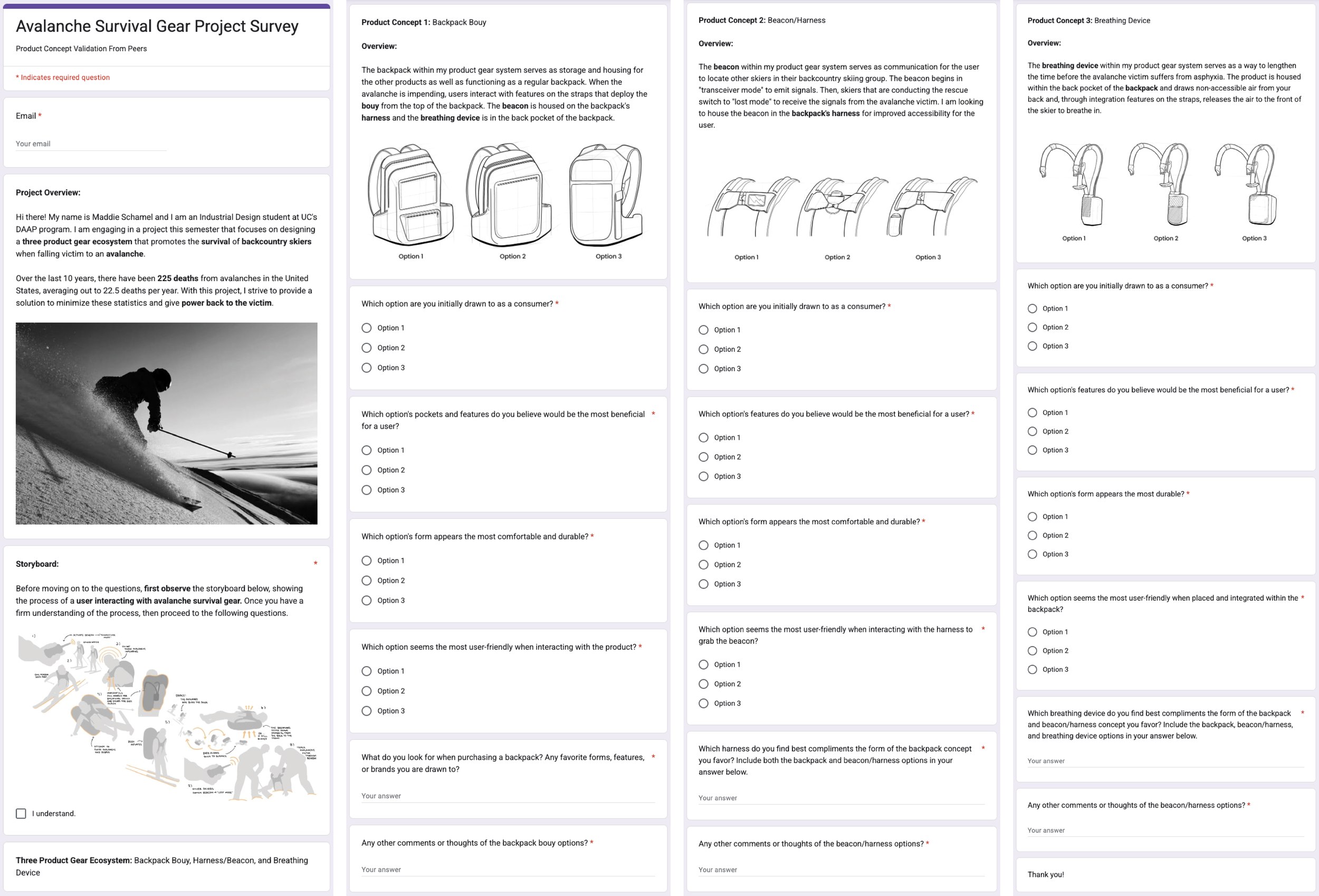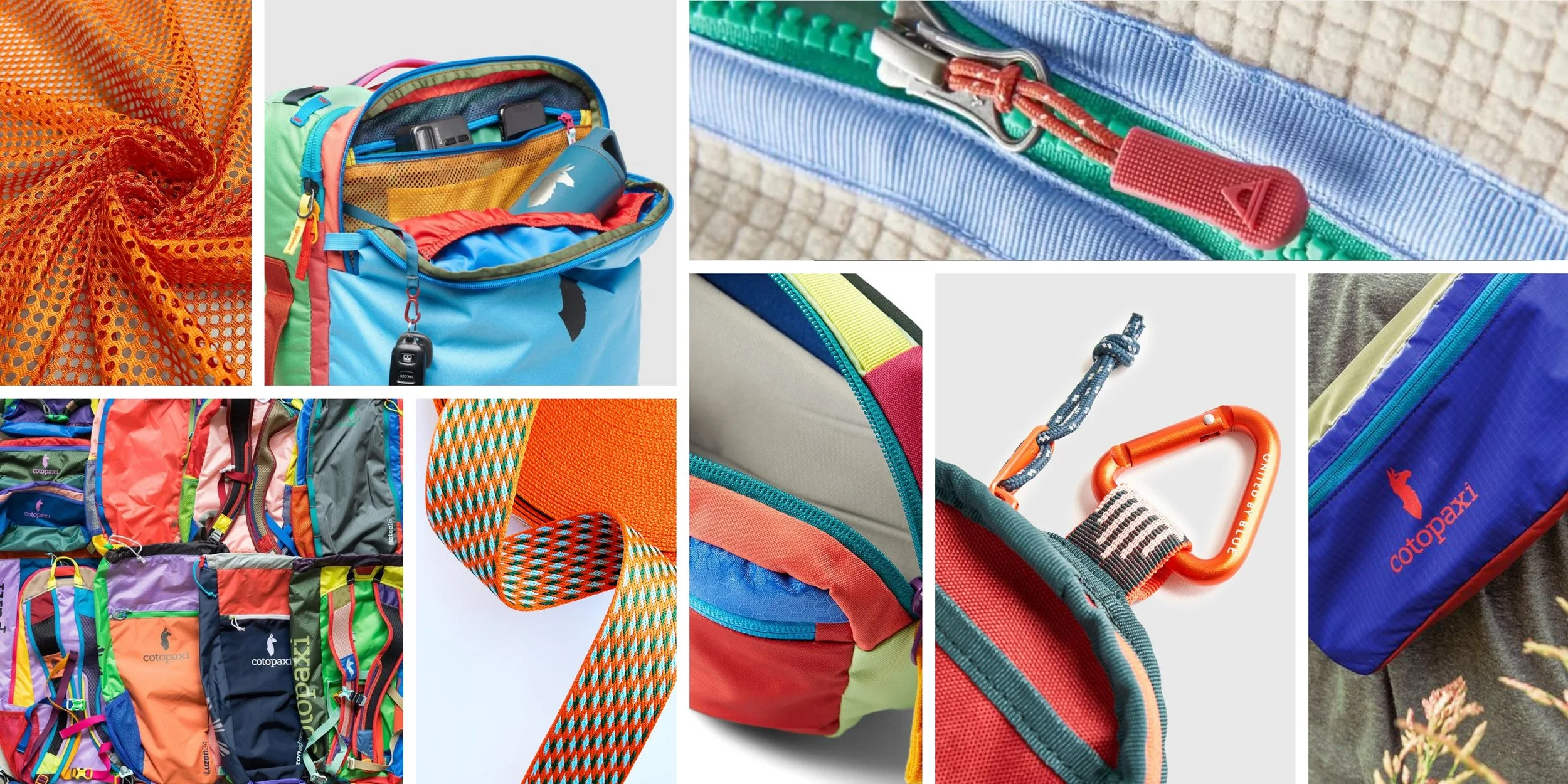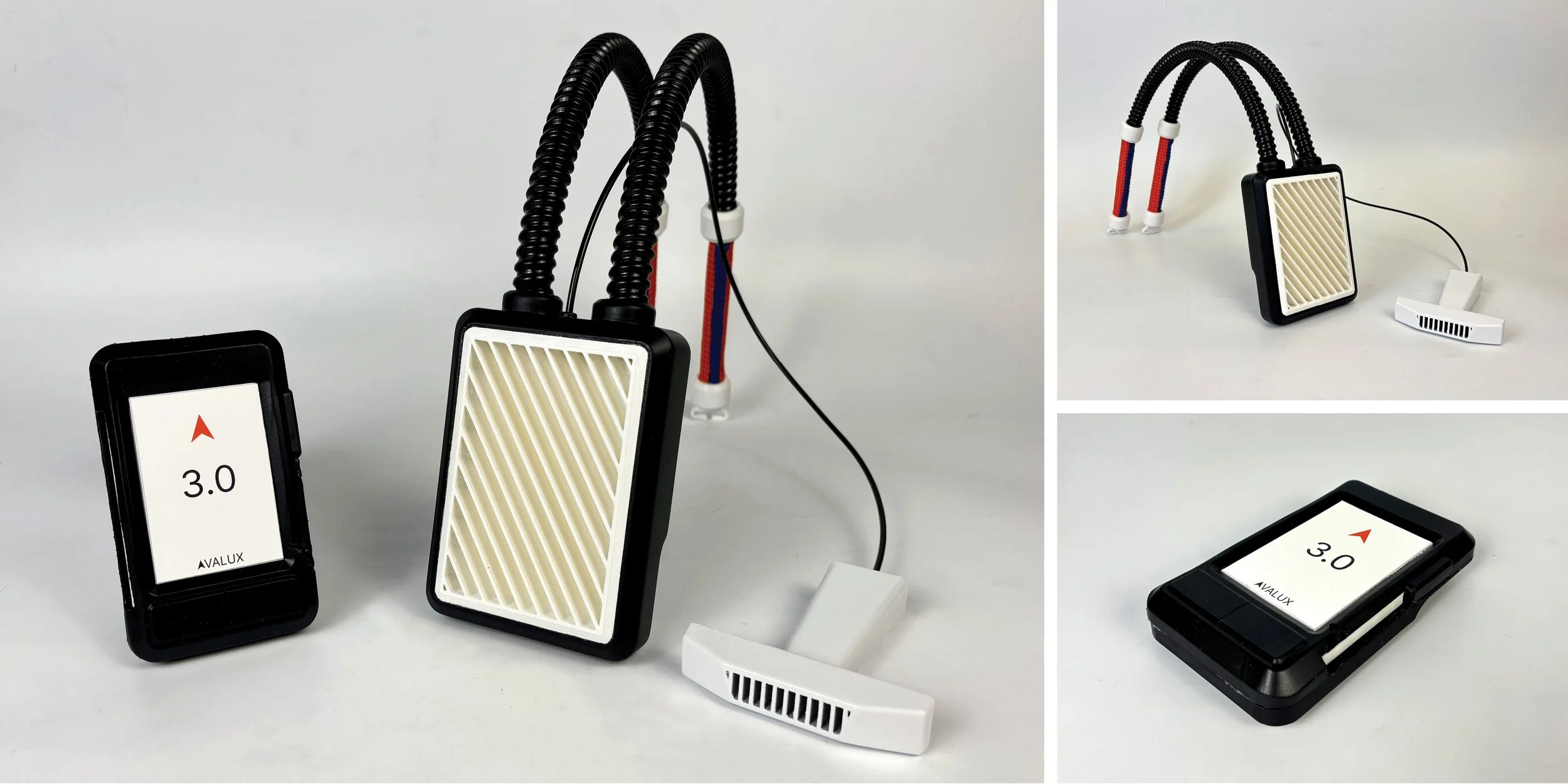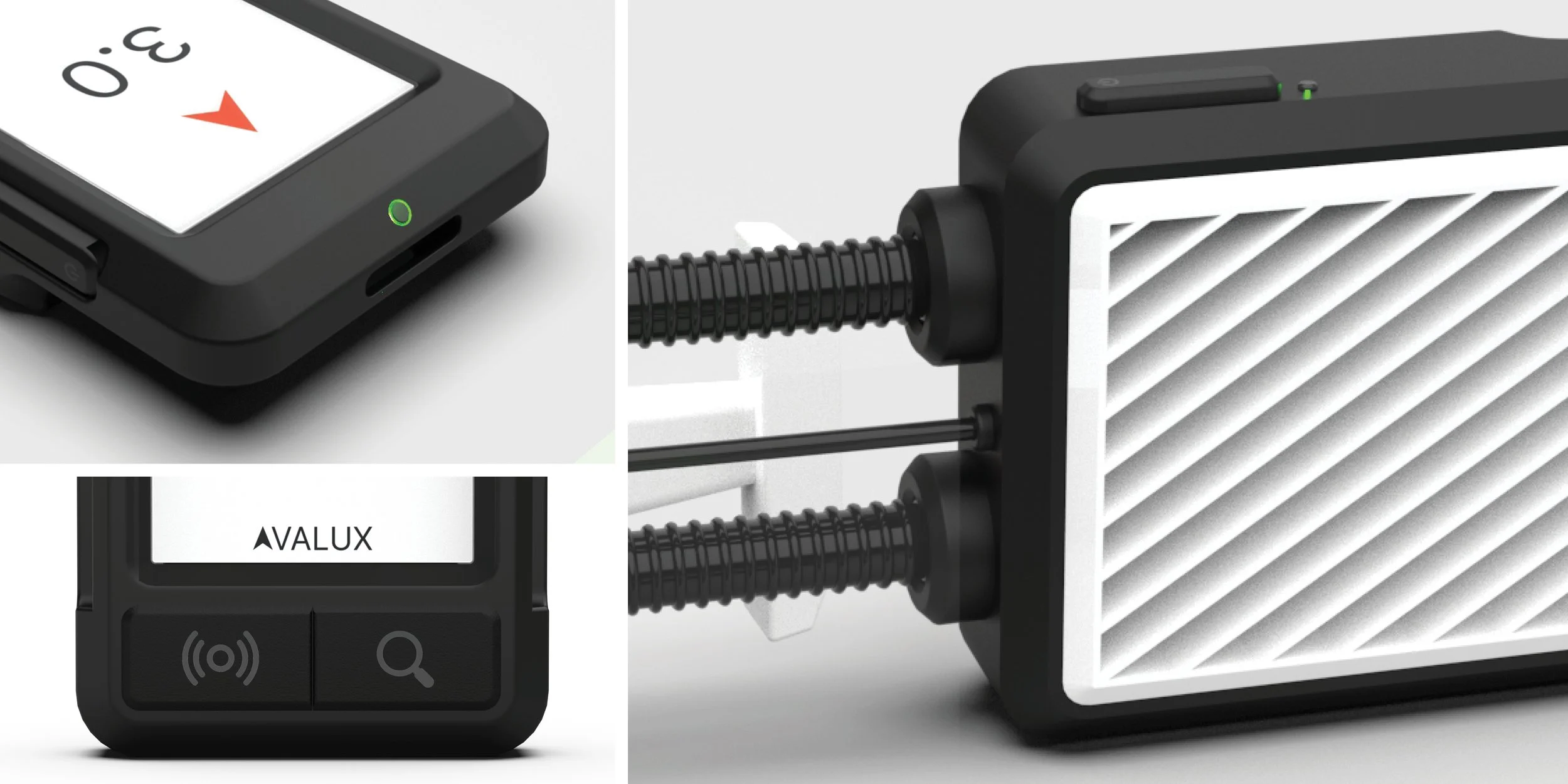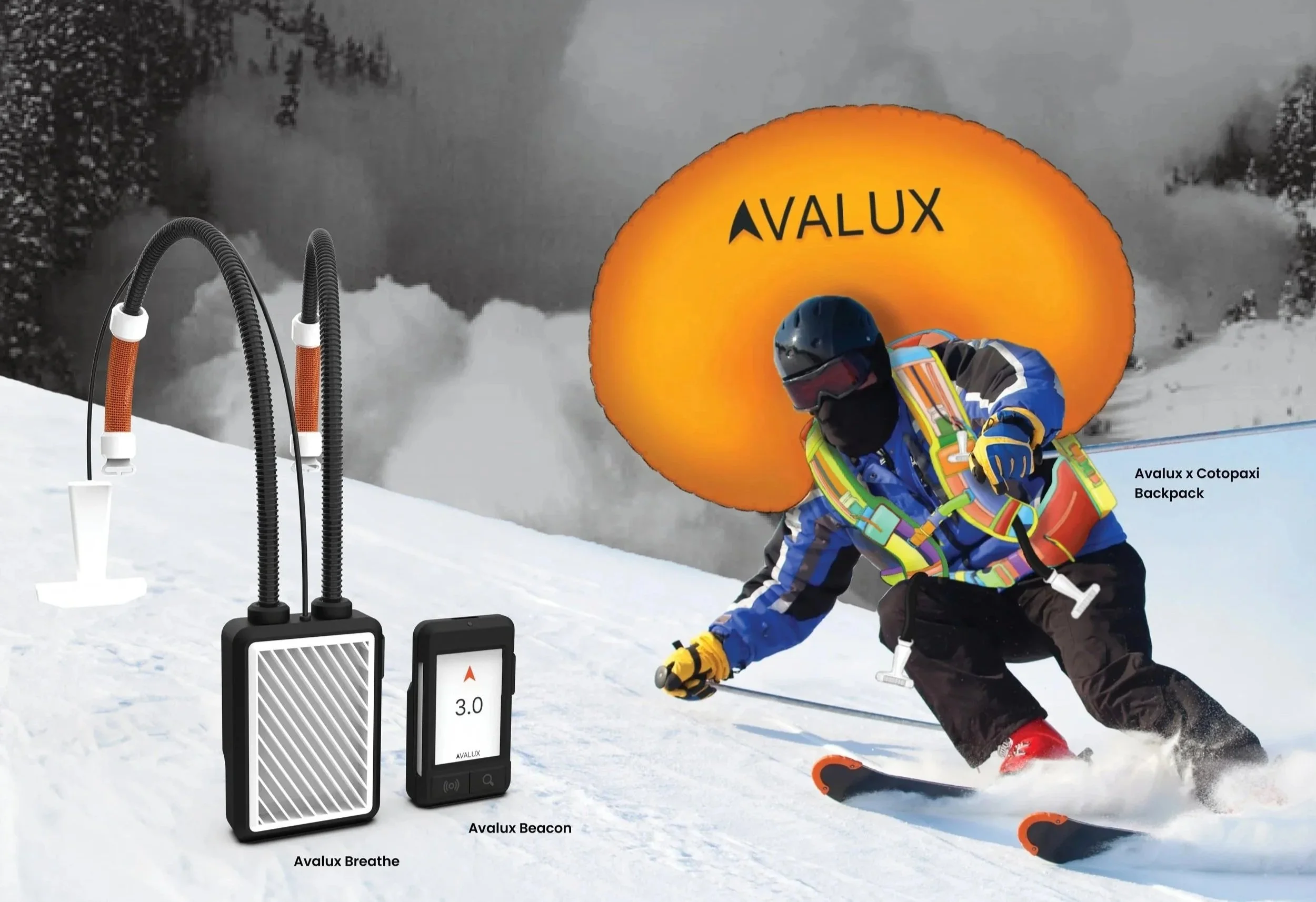Avalux
Not just gear. A second chance.
Duration
15 Weeks
Spring 2025
When every second counts, how can I redesign survival gear products to work together in increasing the user’s survival rate when faced with an avalanche?
Problem Statement
Design Research
User Interviews
Form Ideation
Product Visualization
Disciplines
I regularly listen to survival podcasts, and some of the episodes that have stuck out to me the most are the stories from lone survivors of devastating avalanches. Before conducting user interviews, I first familiarized myself with existing products within an avalanche protocol.
Gear Opportunities
Background
Avalanche airbags were first introduced by Josef Hohenester, a Bavarian forest ranger who surprised himself by surviving an avalanche while crossing a slope with a deer carcass strapped to his back. Other products that can aid those who find themselves in an avalanche include:
Backpack
Beacon
Air supply system
Shovel
Probe
Existing Products
Many products within the toolset of a common backcountry snowboarder or skier have had little to no innovation. While products like the avalanche airbag are increasing in popularity every season, there is room for redesign when envisioning these products working together to increase the user’s survival rate when faced with an avalanche. One of the most influential factors in this success is the education on how to correctly interact with the equipment.
To further explore and analyze the process of encountering such a natural disaster, I reached out to specially trained patrollers and some of the best winter sports experts in the tri-state area. Through interviewing ski instructors and patrollers at Perfect North, I was able to gain a sense of who would be interacting with avalanche survival gear.
User Profiles
Backcountry Skiers and Snowboarders
The backcountry can be anywhere from outside the resort boundaries to the most remote regions of the world. In the backcountry, there’s no lodge or ski patrol. The fresh and untracked snow draws many skiers and snowboarders out while also presenting dangers like avalanches.
To be a successful product, the gear system has to be user-friendly and be able to work together to bring about a swift search and rescue. Based on the findings from my interviews, each piece of equipment has requirements it must adhere to in order to successfully fulfill its role in the gear ecosystem.
Requirements
What is your name, background, and experience at Perfect North?
What products would increase a skier’s avalanche survivability?
Airbag system
Backpack
Beacon
Air supply system
Shovel
Probe
What changes would improve the current protocol?
Educate oneself about avalanches
Have an inflatable backpack that would also protect your head and give you more room to breathe if buried
Have a beacon attached to the chest and backpack
Utilize one’s senses more for sight and sound
Have products that increase your time before asphyxia and hypothermia
What do you like about the current protocol and products?
Confidence in travel decisions after confirming with the avalanche forecast app
Confidence in testing snow and taking a core sample to inspect layers
Ability to conduct quicker searches with newer beacon models
Ability to detect avalanche victims if physical evidence is visible on the surface
Confidence in protocol and steps due to Avalanche Level 1 certification and ski ability
What changes would improve the current products?
Airbag system - Doesn't just serve to keep you afloat, but can also protect from injury, innovating from air canisters to a powered fan, and is user-friendly when triggering and stored in a backpack
Beacon - An innovative UI, strap, or adherence feature so it doesn't get misplaced, and is easy to navigate transmitter/transceiver modes
Air supply system - Part of the backpack rather than a separate product, and releases and does not store the air to help melt the snow
Dave, Director of Ski Patrol since 2008
Ron, 27th Ski Patrol season
Andrew, 20th Ski Patrol season
John, 24th Ski Patrol season
Harold, 16th season of Ski Patrol
Mark, 21st season of Ski Patrol
What do you dislike about the current protocol and products?
Beacons feel outdated with slow updates, poor displays, and limited range
Devices are easy to lose or accidentally reset during use
Frequent recalls and battery reliability issues reduce trust
Switching modes or turning devices off can be inconsistent
Too dependent on consumer-style products and apps that don’t always
work in backcountry
Some of the biggest pain points identified within the user experience are the features of the products themselves. Next features the journey map of a backcountry skier or snowboarder.
Pain Points
Visualization of how the components within my product ecosystem work together during an avalanche.
Task Analysis
1. Activate beacon, transceiver mode
7. Attempt avalanche escape
2. Go down run one at a time
8. Fall victim to avalanche
3. Others watch
8. Oxygen received during avalanche burial
4. Sense avalanche impending, pull handles
9. Others switch beacon, lost mode
5. Bouy inflates
6. Breathing device activates
10. Track and rescue avalanche victim through beacon
Through conducting research in the theory/methods studio, I gained insight on all things trending in winter sports, from fashion to survival. Some of the standout trends I read about include:
Topic Trend Analysis
Recyclable
Brands like Cotopaxi are at the forefront of sustainable, recycled, high-performance clothing. The first thing the brand looks at is whether the product can be made using recycled yarns or whether it’s recyclable.
Smart Ski Equipment
More and more brands are looking to implement technology in their traditional ski equipment. The combination of advanced materials, climate-sensitive equipment, and wearable tech will lead the way in the future of winter sports.
Fashion Statement
Ski fashion is trending towards minimalism and monochrome. However, different types of skiing, like freestyle, always comes with their own fashion personalities.
A List of the narrowed-down components in my system and the features needed to fulfill its function.
Design Direction
Bouy Backpack
Beacon
Modern Interface
Comfortable and intuitive grip
Integration within backpack straps
Multi-step power on and off
Long-lasting power
Multiple antenna
Breathing Device
Adaptable to different backpacks
Easy oxygen deployment
Lightweight, non-bulky form
Long-lasting power
Strong ventilation
Durable materiality
Chest and waist harness buckles
Large storage volume
Durable and weather-resistant
Fan, canister, or battery-powered
Porous pocket for breathing device
Easy buoy deployment
Collaboration with Cotopaxi to create a durable backpack solution that complements the versatile Avalux Beacon, Avalux Breathe, and Avalux Bouy products. The vibrant color palette of the soft good and the addition of harnesses and straps that stay secured to the user offer an impactful product solution for backcountry snowboarders or skiers.
Cotopaxi
Brand Identity
Not only do many winter sports enthusiasts’ values align closely with Cotopaxi’s sustainable brand mission, but the colorful recycled materials that make up these items stand out visually. If the user does fall victim to an avalanche, having such a product on their person draws the eyes of rescuers when contrasting against the fresh white snow.
Exploration of all components focusing on form, aesthetics, and interactive features.
Sketching
User Feedback
Results of conversations with previous interviewees and peers to develop and narrow down on my intended design direction.
Validation
Through further exploration of concepts favored during previous user feedback, I conducted a third round of validation with a larger audience of design peers to narrow down my concepts to their final intended direction.
Analysis of data and responses from interviewees.
Final Direction
Backpack Bouy
“I chose option 3 as a backpack I would be drawn to in the context of sport use. It is sleek and aerodynamic looking and I could see someone wearing it while skiing.” - Interviewee 18
Option 3 was the most popular choice for the backpack across most categories (features, durability, and ease of integration), with 68.6% of respondents drawn to it initially.
Beacon/Harness
“I think option 3 harness complements the option 3 backpack. It adds to the sleek, minimal design.” - Interviewee 6
Option 3 was highly favored for its user-friendliness and comfort, with many citing that it complements the sleekness of the Option 3 backpack.
Breathing Device
“I think breathing device 2 complements harness 3 and backpack 3 again for the cleanliness and simplicity.” - Interviewee 3
Option 2 was generally preferred for its compactness and minimal bulk, with many stating that it fits well with the slim design of the other products.
Design Objectives
Who?
For backcountry skiers and snowboarders.
What?
A three-product avalanche survival gear ecosystem.
Where?
It can be used anywhere one may encounter an avalanche.
When?
Utilize the devices throughout an avalanche disaster event.
Why?
To give power back to the victim and increase avalanche survival.
Backpack Bouy CMF visualization.
Design Inspiration
Beacon CMF visualization.
Breathing Device CMF visualization.
Digitally rendered Backpack solution.
Backpack UX Visualization
The final physical prototypes of the Avalux hardware product ecosystem.
Prototypes
The final design was refined in Autodesk Fusion 360 and visualized in KeyShot to highlight the developed product.


